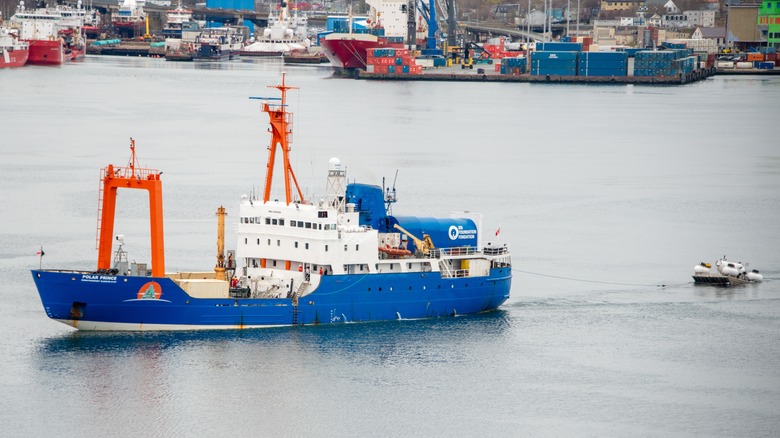Did The Titan Sub Victims Know Their Fate Before The Accident?
When the Canadian vessel Polar Prince lost contact with OceanGate Expeditions' Titan submersible in June 2023, many people hoped for the best while expecting the worst. And indeed, the worst came when it was confirmed that the submersible imploded and killed everyone on board: OceanGate founder Stockton Rush, French diver Paul-Henri Nargeolet, Action Aviation owner Hamish Harding, and Pakistani businessman Shahzada Dawood and his son Suleman. At the time it was generally believed that the sub's mixed materials — titanium and carbon fiber, which have differing elasticities — caused its hull to crack under the ocean's pressure.
The Titan imploded about 11,500 feet under the ocean's surface, a depth so deep that the sub collapsed on itself in a millisecond. In other words, the sub's passengers died faster than the human brain's capability to register physical stimuli. Not only did those on board not suffer, they didn't feel a single thing. And yet, some have wondered if the Titan's passengers had any inkling of their impending deaths — some indication in the sub, sound in the hull, reading on the Titan's display, and so on.
As it turns out, those on board definitely knew something was terribly wrong. As engineer José Luis Martín told Nius (via Diario AS), the sub may have experienced electrical issues right after being submerged in the water, which only became apparent at 5,500 feet below sea level when the sub started to sink uncontrollably. Those on board would have had from 48 to 71 seconds before the end.
A horrifying 48 to 71 seconds
The more details we know about the Titan submersible's destruction, the more horrific it gets, especially because loved ones of the dead are doubtlessly still mourning. But, it pays to learn from the Titan's mistakes so similarly terrible events don't happen in the future. As José Luis Martín told Nuis, the Titan's electrical problems would have caused its thrust to fail. Without proper thrust, it would have started to tilt toward its front end where its porthole was located. This would have disrupted the vessel's "longitudinal stability," as engineer José Luis Martín told Nius.
He painted a grisly picture of this moment, pointing out that all five people on the sub would have piled onto each other in a heap. The sub's porthole would have emitted no light at that depth, and it's unclear whether the sub's internal lights were working. Martin also said Titan's emergency lever, meant to release weights that let the submarine more easily rise to the surface, wouldn't have worked (per the New York Post). It's possible that someone on board — likely OceanGate founder Stockton Rush, who was piloting the vessel — would have tried to activate this emergency mechanism unsuccessfully. Meanwhile, the submarine was tilted and sinking into darkness. As mentioned, this scene would have lasted a terrifying 48 to 71 seconds during which those on board knew that there was no escape.
Sub-standard sub design
It's unlikely that there were any red flags about the Titan submersible's impending disaster when the vessel set out from the Polar Prince — at least regarding the craft's moment-to-moment operations. The submarine was on a mission to view the wreckage of the Titanic, a feat achieved by less than 250 people in the 112 years since the boat sunk. The doomed Titan had actually visited the Titanic 13 times prior and acted as a kind of tourist craft for wealthy passengers to visit history's most famous sunken ship.
And yet, OceanGate shareholder and four-time Titan passenger Arron Newman told MSNBC's Ali Velsh that the Titan was still a prototype. In fact, David Lochridge, OceanGate's director of marine operations, found in a report that the sub's viewport — the part of the vessel where passengers sit and look out its porthole — was only certified for less than one-third of the depth to which the vessel descended when viewing the Titanic (per The New York Times). This would be a shocking revelation even if the Titan only visited the Titanic once, let alone 14 times. It stands to reason that the stress of so many trips — in what turned out to be a sub-standard vessel — might have been no small reason why the Titan's titanium and carbon fiber shell cracked and its electronics failed.
So did those on board the Titan know about their fate? Not until at least 71 seconds before death, apparently. But it seems those responsible for the mission could have foreseen and prevented it's doom with the application of the least bit more care.


